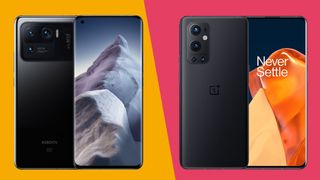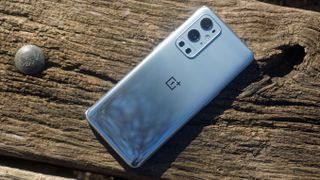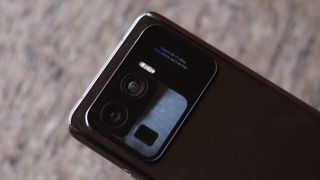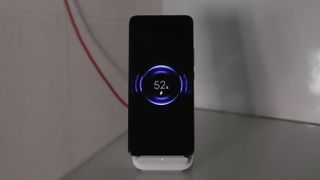
Do you need to spend upwards of $1,100/£1,000/AU$1,800 on an ‘Ultra’ smartphone? For those wishing to make the case against, comparing the Xiaomi Mi 11 Ultra with the OnePlus 9 Pro might seem to be a smart tactic.
The Xiaomi Mi 11 Ultra typifies the kind of excess that can be a hallmark of the super-elite smartphone category. It’s chock-full of features that are impressive on paper, but of questionable value in practice.
In the other corner we have the OnePlus 9 Pro, which offers a highly accomplished flagship experience whilst keeping the price relatively sensible - if not exactly cheap.
When you get down to it, though, these are two very good phones with top notch power and superb cameras. So which is the better buy?
Xiaomi Mi 11 Ultra vs OnePlus 9 Pro price and availability
The Xiaomi Mi 11 Ultra hit shops on April 2, 2021, with prices starting from £1,199 / AU$1,799 (around $1,600) for 256GB of storage.
The OnePlus 9 Pro landed on March 30, 2021, with prices starting from $969 / £829 (roughly AU$1,250) for 8GB of RAM / 128GB of storage. Cranking things up to 12GB/256GB will set you back $1069 / £929 (about AU$1,400).
We’re looking at a like-for-like price difference of £270 (around $375 / AU$510) in favor of the OnePlus 9 Pro.
Get daily insight, inspiration and deals in your inbox
Get the hottest deals available in your inbox plus news, reviews, opinion, analysis and more from the TechRadar team.
Neither of these phones is globally available, however. You can’t buy the OnePlus 9 Pro in Australia, while you can’t buy the Xiaomi Mi 11 Ultra in the US.

Design
Neither of these phones boasts our favorite design on the market, but one thing’s for sure: the OnePlus 9 Pro is way more pleasant to live with.
The Xiaomi Mi 11 Ultra is the more distinctive and stylish, though. Its classy ceramic rear and stand-out camera module, together with two-tone finish, make it look a bit like EVE from WALL-E. That can’t be a bad thing.
By contrast, the OnePlus 9 Pro looks a little drab - a cookie cutter smartphone design with no stand-out elements other than a Morning Mist shade that looks a bit like a fogged up mirror.

The problems start with the Xiaomi Mi 11 Ultra’s extreme weight. At 234g, it’s a massive 37g more than the 197g OnePlus. While it might seem like the Xiaomi is thinner at 8.4mm, with the OnePlus coming in at 8.7mm, that would be to ignore the camera module-shaped elephant in the room.
This photographic protuberance is huge, spreading across almost the entire width of the phone and standing out for a total thickness of over 10mm. Our reviewer resorted to carrying the Mi 11 Ultra around in their backpack, because it just didn’t fit in their jeans pocket.

The OnePlus 9 Pro might be relatively boring to look at, but it’s way more pocketable, and its smaller camera module is less likely to snag on pockets.
You also get that OnePlus physical alert switch on the right-hand edge, which makes it a doddle to switch between loud, silent, and vibrate.
Elsewhere, both phones have subtly curved displays and IP68 ratings, mixing style with robustness.
Display
We can’t fault either of these displays. Both can hit a 120Hz refresh rate and a QHD resolution simultaneously, and both output exquisite colors and deep blacks.
But the Xiaomi Mi 11 Ultra's display takes the edge in a couple of areas. It’s larger, for one thing, at 6.81-inches compared to the OnePlus 9 Pro’s 6.7-inch equivalent.
It can also get much brighter, to the tune of 1700 nits compared to the OnePlus 9 Pro’s 1300 nits. Xiaomi also has the edge when it comes to touch responsiveness, with an incredible 480Hz touch sampling rate compared to the OnePlus 9 Pro’s 360Hz. This will only be of use to hardcore gamers, but it’s an advantage nonetheless.

Both phones incorporate in-display fingerprint sensors, but we’d probably give OnePlus the edge here. The Xiaomi Mi 11 Ultra’s sensor doesn’t always recognize your prints as reliably as we would like.
We should also talk about the Xiaomi Mi 11 Ultra’s secondary 1.1-inch display. Located the back of the phone, as part of that ridiculous camera module, it’s a bizarrely superfluous addition.
In normal use, you can use it to tell the time and battery level from the rear, which is rather pointless. More useful is the ability to use it as a camera viewfinder for super-powered selfies, though it’s not quite big enough to see from a distance.
It’ll also activate with music app control shortcuts, though this proves a liability when it comes to accidental touches. All in all, we wish Xiaomi hadn’t bothered.
Camera
Both of these Chinese manufacturers make big claims about their camera systems, and both sets of boasts have considerable merit.
While the Xiaomi Mi 11 Ultra’s camera module is a bit of a liability from a practical perspective, it’s all in the service of the largest sensors we’ve ever seen in a smartphone. At 1/1.12-inch, it dwarfs the (still pretty large) 1/1.43-inch main sensor of the OnePlus 9 Pro.
This difference means that while the Xiaomi packs in more pixels (50MP vs 48MP), those pixels are also much larger (1.4µm vs 1.12µm). Sure enough, pictures taken with the Xiaomi’s main camera look brilliantly bright and bold, with a natural sense of depth and a level of detail that not many rivals can match.

But the OnePlus 9 Pro takes its own path to photographic excellence. With the help of camera specialist Hasselblad, OnePlus’s color calibration has progressed significantly, with a cool, natural tone.
The OnePlus can also capture 12-bit RAW shots through manual modes, and its Digital Overlap HDR (DOL-HDR) feature lessens the ghosting in HDR shots by shooting long and short exposures nigh-on simultaneously.
When it comes to the ultra-wides, the megapixel count swaps around. The Xiaomi Mi 11 Ultra packs a 48MP sensor, while the OnePlus 9 Pro features a 50MP sensor.
The OnePlus 9 Pro gets the edge here with an innovative freeform lens, which greatly lessens visual distortions. Conversely, the Xiaomi’s shots are noticeably distorted at the edges. The Mi 11 Ultra’s ultra-wide also produces rather iffy macro shots.

Xiaomi wins points back with its 48MP f/4.1 5x periscope lens, while the OnePlus 9 Pro has a relatively meagre 8MP f/2.4 3.3x equivalent. The Xiaomi Mi 11 Ultra claims to produce up to 120x hybrid zoom shots, though in practice it’s really only good for 30x. But that’s pretty awesome in itself.
In short, the Xiaomi Mi 11 Ultra takes great 1x shots and fantastic zoomed shots, while the OnePlus 9 Pro takes great 1x shots and fantastic ultra-wide shots.
In terms of selfie cameras, the Xiaomi has a 20MP unit, while the OnePlus has a 16MP equivalent. The Xiaomi Mi 11 Ultra also has that secondary display, which make shooting selfies with the main camera potentially easier.
The Xiaomi Mi 11 Ultra can capture 8K video at 24fps and 4K video at 60fps, while the OnePlus can take 8K video at 30fps and 4K video at 120fps. Advantage OnePlus, then, though video shot on the Mi 11 Ultra was some of the best we’ve seen captured on a phone.
Specs and performance
Both the Xiaomi Mi 11 Ultra and the OnePlus 9 Pro use the Snapdragon 888 chipset. The Xiaomi comes with 12GB of RAM as standard, while the OnePlus offers the option of either 8GB or 12GB.
The OnePlus 9 Pro slightly pipped the Xiaomi Mi 11 Ultra in our Geekbench 5 tests - 3,620 vs 3,519 - but that really isn’t consequential. Both of these phones fly through tasks just as fluidly.
One thing we should note is that the Xiaomi Mi 11 Ultra can run rather hot under load, such as when gaming. Meanwhile the OnePlus 9 Pro has an advanced ‘Cool Play’ vapor chamber that keeps things on a relatively even keel.

The OnePlus gets a far bigger win on the software front. Xiaomi’s MIUI is pretty divisive, with stacks of customization potential on one hand, and lots of bugs and bloatware on the other.
Compared to that, OnePlus’s OxygenOS is a blessed relief. It’s fast, fluid, stylish, and blissfully free of bloatware. We really hope the Oppo merger doesn’t spoil things in future, but for now it’s the Android UI king.
Storage is fairly equal. The Xiaomi Mi 11 Ultra comes with 256GB - there is a 512GB model, but this doesn't appear to be widely available. Meanwhile the OnePlus 9 Pro gives you 128GB or 256GB of internal storage. Neither phone sports a microSD card slot.
Battery
The Xiaomi Mi 11 Ultra has the bigger battery of the two at 5,000mAh. Over in the OnePlus 9 Pro corner, you have to make do with a mere 4,500mAh.
That said, the Xiaomi Mi 11 Ultra appears to be placing more strain on that larger battery. Its display is larger and brighter, and it seems to be caught flipping between 60Hz and 120Hz, while the OnePlus 9 Pro can smartly scale as low as 1Hz where necessary.
As we’ve also mentioned, the Xiaomi Mi 11 Ultra seems to run a little hot compared to its cool-as-a-cucumber rival. And heat really is the enemy of battery life.
Sure enough, with the Xiaomi Mi 11 Ultra, we found a day of relatively light usage would leave us with just 10% to 20% left in the tank. More typical use would drain it completely by the time we were tucked up in bed.

Conversely, our reviewer found that the OnePlus 9 Pro would last through a full day of moderate usage, with only one or two occasions where they had to recharge before 10pm.
Both phones go big on charging tech. The Xiaomi Mi 11 Ultra bundles in a 67W charger, while the OnePlus is only fractionally behind on 65W. Both will get you from 0 to 100% in around 30 minutes, which is superb.
Xiaomi ekes out a larger lead when it comes to wireless charging, with support for the very same 67W speeds. The OnePlus can only manage 50W, though that’s still awesome in its own right.
Takeaway
Both of these manufacturers have brought their A-game when it comes to power, display technology, camera capabilities, and charging standards. Taken point by point, it’s nip and tuck throughout.
But the OnePlus 9 Pro is simply a much more cohesive, considered phone when viewed as a whole. It’s just as powerful as the Xiaomi Mi 11 Pro, while its display isn’t meaningfully inferior, and charging speeds are in the same ballpark.
The OnePlus 9 Pro’s main camera can compete with the monstrous sensor of its rival too, thanks to some smart image processing techniques, while its ultra-wide sensor is even better. The Xiaomi wins on telephoto shots, but it’s much more competitive overall than you might expect.
But where the OnePlus really wins out is in the fact that it’s much easier to live with day to day thanks to its slimmer, lighter design, more even battery performance, and flat out superior UI. All this and it’s also hundreds of dollars/pounds cheaper, making for a much more comfortable win than it might seem on paper.
- After other inspiration? Take a look at all the best smartphones
